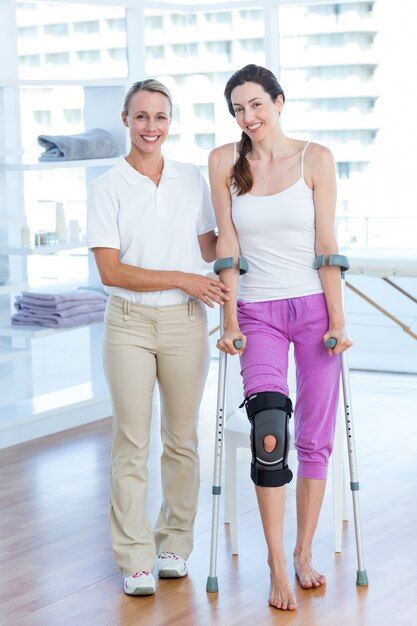john@lee-mat.com
+86-13510662576

GET QUOTE
How to Wear Elastic Knee Support?
What's the Advantages of Wearing Elastic Knee Support?
- Pain Relief for Various Conditions: From arthritis to mild strains, elastic knee supports can offer significant pain relief. The compression they provide helps manage pain by reducing stress on the joint, making them a valuable asset for individuals dealing with chronic knee issues.
- Post-Injury Recovery: For those on the road to recovery after a knee injury, an elastic knee support becomes a trusted ally. It provides a gentle compression that supports the healing process, allowing you to regain mobility and strength more comfortably.
3. Prevention of Injuries: An ounce of prevention is worth a pound of cure. Wearing an elastic knee support during physical activities or sports can act as a preventive measure, reducing the risk of injuries by providing extra support to the knee ligaments and tendons.
How Long Should You Wear Elastic Knee Support?
The duration for wearing an elastic knee support can vary based on the specific situation, individual needs, and the recommendation of a healthcare professional. Here are some general guidelines:
During Physical Activities: If you're wearing an elastic knee support for added stability during physical activities or sports, it's typically worn during the entire duration of the activity. This helps provide continuous support and reduces the risk of injuries during movement.
Post-Injury or Surgery: For post-injury recovery or after knee surgery, the duration of wearing an elastic knee support can vary. In many cases, healthcare professionals may recommend wearing it consistently for a certain period, especially during weight-bearing activities. As the healing progresses, the need for continuous use may decrease.
Chronic Conditions: Individuals with chronic knee conditions, such as arthritis, may benefit from wearing an elastic knee support regularly. It can be worn throughout the day to provide ongoing support and alleviate discomfort. However, it's essential to take breaks to allow the knee to move naturally and prevent dependence on the support.
As Needed for Pain Management: If you're using an elastic knee support for pain management, the duration of wear may depend on the severity of the pain and your comfort level. Some individuals may choose to wear it as needed during activities that exacerbate the pain, while others may find consistent use more beneficial.
Choosing the Right Fit:
Start by selecting the right size for your knee support. Measure the circumference of your knee at the midpoint and refer to the manufacturer's size chart. A snug fit is crucial for optimal support without restricting blood circulation.
Putting It On:
Prepare Your Skin: Ensure your knee area is clean and dry before putting on the support. This helps prevent skin irritation and ensures a comfortable fit.
Slide It Up: Roll or slide the knee support up your leg, positioning it so the opening is directly over your kneecap. Make sure it sits comfortably without digging into your skin.
Adjust as Needed: If your knee support has adjustable straps, use them to achieve a customized fit. The goal is to have a secure fit without it being too tight.
When to Wear It:
Elastic knee supports are versatile and can be worn in various situations. Whether you're engaging in physical activity, recovering from an injury, or simply dealing with everyday knee discomfort, these supports can provide the relief you need.
Dos and Don'ts:
Do Wash Regularly: Keep your knee support clean by washing it regularly. Follow the care instructions provided by the manufacturer.
Don't Wear All the Time: While elastic knee supports offer support, it's essential to let your knees move naturally. Avoid wearing them for extended periods if not necessary.
Do Replace When Necessary: Elastic materials can lose their elasticity over time. If you notice signs of wear and tear, invest in a new knee support for continued effectiveness.
Additional Tips:
Combine with Exercise: Pairing your elastic knee support with targeted knee exercises can enhance its benefits.
Consider Your Footwear: Wearing supportive shoes complements the effectiveness of knee supports.
Conclusion:
Wearing an elastic knee support doesn't need to be complicated. By choosing the right size, putting it on correctly, and following a few simple guidelines, you can enjoy the benefits of added knee support effortlessly.

